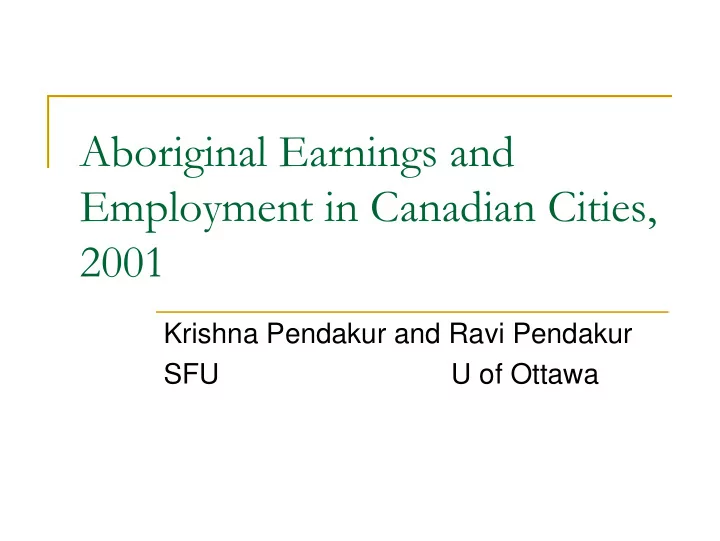

Aboriginal Earnings and Employment in Canadian Cities, 2001 Krishna Pendakur and Ravi Pendakur SFU U of Ottawa
Goals � How do Aboriginal (Indian) registration, Aboriginal identity and Aboriginal ancestry play into patterns of employment and earning disparity? � How does Aboriginal employment and earnings vary across Canada's largest cities?
Previous work � Previous research has focused mostly on the relevance of “aboriginal origin” to labour market success � Papers establish that the earnings of Aboriginal-origin people in Canada are extremely low relative to the non- Aboriginal-origin population (George et al. (1994), Drost (1994), Pendakur and Pendakur (1998), Kuhn and Sweetman (1998, 2002), DeSilva (1999)) � A few papers have used the “aboriginal identity” definition (Clatworthy 1995, Mendelson 2004). � Results are often hampered by small sample size.
Model of labour market outcomes 90% Aboriginal groups: 80% Status - on reserve 50% Earnings - Off reserve SELECTION Identity Canadian-born • Census family status - NAI Males or • Schooling - Métis Females 20% • Age - Inuit 25-64 • City - multiple • Language With some Ancestry schooling Majority origins Odds of Job characteristics: employment -Occupation -Industry -Weeks, full time
Relative Odds of Employment, Aboriginal groups vs British origin, Canada Reg. on reserve Reg. off reserve Females N. Amer Indian Metis Aboriginal Heritage Reg. on reserve Reg. off reserve Males N. Amer Indian Metis Aboriginal Heritage 0% 10% 20% 30% 40% 50% 60% 70% 80% 90% 100%
Relative Odds of Employment, Aboriginal groups vs British origin, Winnipeg Reg. on reserve Reg. off reserve Females N. Amer Indian Metis Aboriginal Heritage Reg. on reserve Reg. off reserve Males N. Amer Indian Metis Aboriginal Heritage 0% 10% 20% 30% 40% 50% 60% 70% 80% 90% 100%
Relative Odds of Employment, Aboriginal groups vs British origin, Vancouver Reg. on reserve Reg. off reserve Females N. Amer Indian Metis Aboriginal Heritage Reg. on reserve Reg. off reserve Males N. Amer Indian Metis Aboriginal Heritage 0% 10% 20% 30% 40% 50% 60% 70% 80% 90% 100%
Mean earnings differentials (%) controlling for personal and work characteristics, Aboriginal groups vs British only ancestry, Canada, Males Reg. on reserve Reg. off reserve N. Amer. Indian Métis Aborig. Heritage -50% -45% -40% -35% -30% -25% -20% -15% -10% -5% 0% Personal Personal & Work
Mean earnings differentials (%) controlling for personal & work characteristics, Aboriginal groups vs British only ancestry, Canada, Females Reg. on reserve Reg. off reserve N. Amer. Indian Métis Aborig. Heritage -25% -20% -15% -10% -5% 0% Personal Personal & Work
Mean earnings differentials (%) controlling for personal & work characteristics, Aboriginal groups vs British only ancestry, Winnipeg, Males Reg. on reserve Reg. off reserve N. Amer. Indian Métis Aborig. Heritage -50% -45% -40% -35% -30% -25% -20% -15% -10% -5% 0% Personal Personal & Work
Mean earnings differentials (%) controlling for personal & work characteristics, Aboriginal groups vs British only ancestry, Winnipeg, Females Reg. on reserve Reg. off reserve N. Amer. Indian Métis Aborig. Heritage -30% -25% -20% -15% -10% -5% 0% Personal Personal & Work
Mean earnings differentials (%) controlling for personal & work characteristics, Aboriginal groups vs British only ancestry, Vancouver, Males Reg. on reserve Reg. off reserve N. Amer. Indian Métis Aborig. Heritage -50% -45% -40% -35% -30% -25% -20% -15% -10% -5% 0% Personal Personal & Work
Mean earnings differentials (%) controlling for personal & work characteristics, Aboriginal groups vs British only ancestry, Vancouver, Females Reg. on reserve Reg. off reserve N. Amer. Indian Métis Aborig. Heritage -45% -40% -35% -30% -25% -20% -15% -10% -5% 0% Personal Personal & Work
Earnings differentials Aboriginal groups vs British Origin, at the 20 th , 50 th , 80 th and 90 th percentile, controlling for personal characteristics, Canada, Males 0.00 -0.10 -0.20 -0.30 -0.40 -0.50 -0.60 -0.70 q20 q50 q80 q90 Reg. on reserve Reg. off reserve N. Amer. Indian Métis Aborig. Heritage
Earnings differentials Aboriginal groups vs British Origin, at the 20 th , 50 th , 80 th and 90 th percentile, controlling for personal characteristics, Canada, Females 0.00 -0.05 -0.10 -0.15 -0.20 -0.25 -0.30 -0.35 -0.40 -0.45 q20 q50 q80 q90 Reg. on reserve Reg. off reserve N. Amer. Indian Métis Aborig. Heritage
Earnings differentials Aboriginal groups vs British Origin, at the 20 th , 50 th , 80 th and 90 th percentile, controlling for personal characteristics, Vancouver, Males 0.00 -0.10 -0.20 -0.30 -0.40 -0.50 -0.60 -0.70 q20 q50 q80 q90 Reg. on reserve Reg. off reserve N. Amer. Indian Métis Aborig. Heritage
Earnings differentials Aboriginal groups vs British Origin, at the 20 th , 50 th , 80 th and 90 th percentile, controlling for personal characteristics, Vancouver, Females 0.10 0.00 -0.10 -0.20 -0.30 -0.40 -0.50 -0.60 q20 q50 q80 q90 Reg. on reserve Reg. off reserve N. Amer. Indian Métis Aborig. Heritage
Conclusions 2 Men and women fare differently. The disparity, 1. both in employment prospects and earnings amongst men is always greater than is the case for women. Results vary by city. Cities are labour markets and 2. in some, Aboriginals do better, while in others they do worse. Vancouver stands out as particularly bad. The link between employment and earnings is 3. strong. Where employment probabilities are low, earnings are also low, suggesting that the two reinforce each other.
Conclusions 2 There is no strength in numbers. Employment and 1. earnings are low in Prairie cities despite large aboriginal populations. We are looking at a sticky floor rather than a glass 2. ceiling. Those people at the upper end face far less discrimination than those at the bottom end. There is a fairly consistent hierarchy of labour 3. market outcomes amongst Aboriginal men and women. Registered Indians (particularly men on reserves) fare the worst. In contrast to Drost and Richards, we find that 4. among registered Aboriginals, Men do better off reserve and women do better on reserve.
Recommend
More recommend